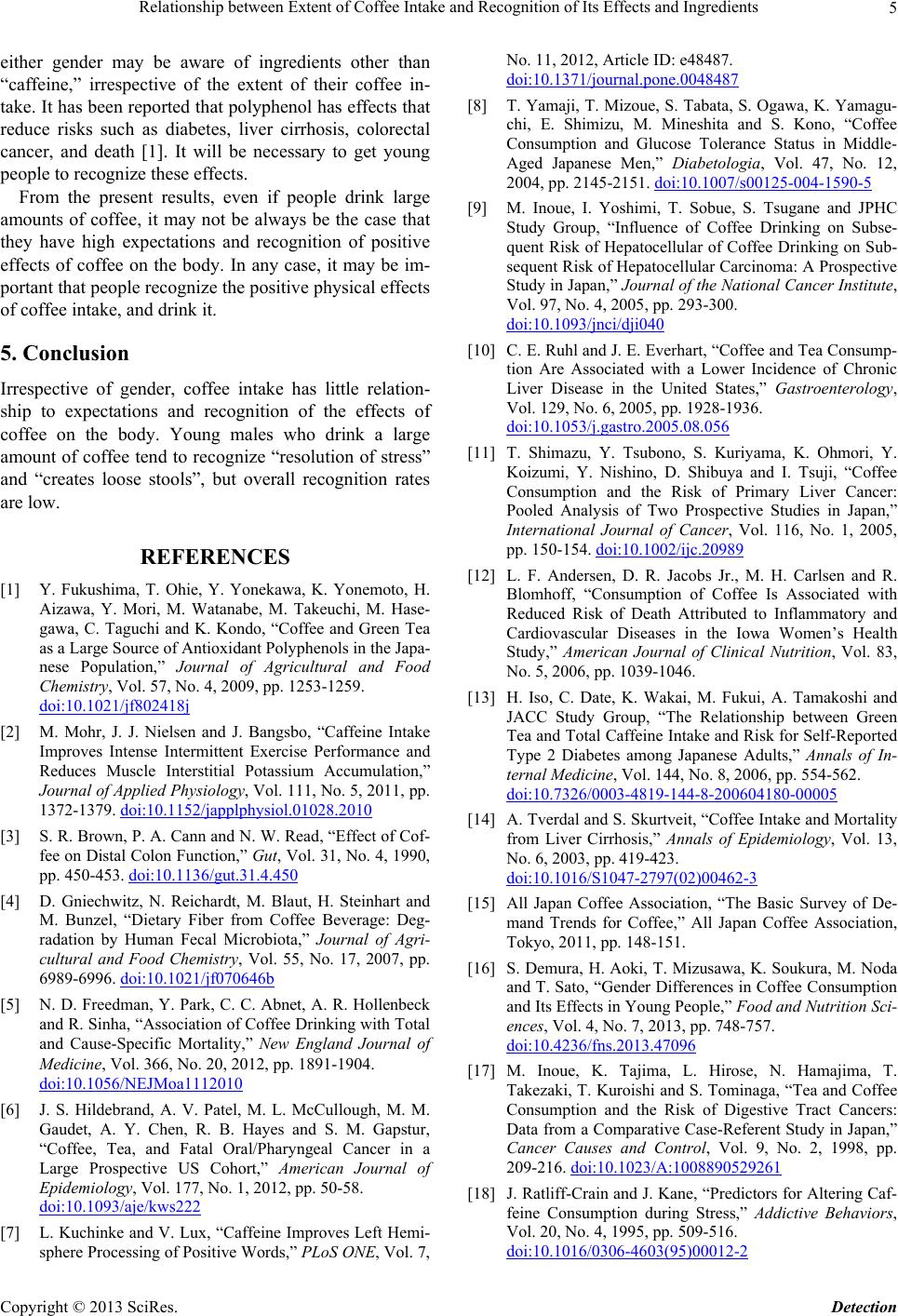
Relationship between Extent of Coffee Intake and Recognition of Its Effects and Ingredients 5
either gender may be aware of ingredients other than
“caffeine,” irrespective of the extent of their coffee in-
take. It has been reported that polyphenol has effects that
reduce risks such as diabetes, liver cirrhosis, colorectal
cancer, and death [1]. It will be necessary to get young
people to recognize these effects.
From the present results, even if people drink large
amounts of coffee, it may not be always be the case that
they have high expectations and recognition of positive
effects of coffee on the body. In any case, it may be im-
portant that people recognize the positive physical effects
of coffee intake, and drink it.
5. Conclusion
Irrespective of gender, coffee intake has little relation-
ship to expectations and recognition of the effects of
coffee on the body. Young males who drink a large
amount of coffee tend to recognize “resolution of stress”
and “creates loose stools”, but overall recognition rates
are low.
REFERENCES
[1] Y. Fukushima, T. Ohie, Y. Yonekawa, K. Yonemoto, H.
Aizawa, Y. Mori, M. Watanabe, M. Takeuchi, M. Hase-
gawa, C. Taguchi and K. Kondo, “Coffee and Green Tea
as a Large Source of Antioxidant Polyphenols in the Japa-
nese Population,” Journal of Agricultural and Food
Chemistry, Vol. 57, No. 4, 2009, pp. 1253-1259.
doi:10.1021/jf802418j
[2] M. Mohr, J. J. Nielsen and J. Bangsbo, “Caffeine Intake
Improves Intense Intermittent Exercise Performance and
Reduces Muscle Interstitial Potassium Accumulation,”
Journal of Applied Physiology, Vol. 111, No. 5, 2011, pp.
1372-1379. doi:10.1152/japplphysiol.01028.2010
[3] S. R. Brown, P. A. Cann and N. W. Read, “Effect of Cof-
fee on Distal Colon Function,” Gut, Vol. 31, No. 4, 1990,
pp. 450-453. doi:10.1136/gut.31.4.450
[4] D. Gniechwitz, N. Reichardt, M. Blaut, H. Steinhart and
M. Bunzel, “Dietary Fiber from Coffee Beverage: Deg-
radation by Human Fecal Microbiota,” Journal of Agri-
cultural and Food Chemistry, Vol. 55, No. 17, 2007, pp.
6989-6996. doi:10.1021/jf070646b
[5] N. D. Freedman, Y. Park, C. C. Abnet, A. R. Hollenbeck
and R. Sinha, “Association of Coffee Drinking with Total
and Cause-Specific Mortality,” New England Journal of
Medicine, Vol. 366, No. 20, 2012, pp. 1891-1904.
doi:10.1056/NEJMoa1112010
[6] J. S. Hildebrand, A. V. Patel, M. L. McCullough, M. M.
Gaudet, A. Y. Chen, R. B. Hayes and S. M. Gapstur,
“Coffee, Tea, and Fatal Oral/Pharyngeal Cancer in a
Large Prospective US Cohort,” American Journal of
Epidemiology, Vol. 177, No. 1, 2012, pp. 50-58.
doi:10.1093/aje/kws222
[7] L. Kuchinke and V. Lux, “Caffeine Improves Left Hemi-
sphere Processing of Positive Words,” PLoS ONE, Vol. 7,
No. 11, 2012, Article ID: e48487.
doi:10.1371/journal.pone.0048487
[8] T. Yamaji, T. Mizoue, S. Tabata, S. Ogawa, K. Yamagu-
chi, E. Shimizu, M. Mineshita and S. Kono, “Coffee
Consumption and Glucose Tolerance Status in Middle-
Aged Japanese Men,” Diabetologia, Vol. 47, No. 12,
2004, pp. 2145-2151. doi:10.1007/s00125-004-1590-5
[9] M. Inoue, I. Yoshimi, T. Sobue, S. Tsugane and JPHC
Study Group, “Influence of Coffee Drinking on Subse-
quent Risk of Hepatocellular of Coffee Drinking on Sub-
sequent Risk of Hepatocellular Carcinoma: A Prospective
Study in Japan,” Journal of the National Cancer Institute,
Vol. 97, No. 4, 2005, pp. 293-300.
doi:10.1093/jnci/dji040
[10] C. E. Ruhl and J. E. Everhart, “Coffee and Tea Consump-
tion Are Associated with a Lower Incidence of Chronic
Liver Disease in the United States,” Gastroenterology,
Vol. 129, No. 6, 2005, pp. 1928-1936.
doi:10.1053/j.gastro.2005.08.056
[11] T. Shimazu, Y. Tsubono, S. Kuriyama, K. Ohmori, Y.
Koizumi, Y. Nishino, D. Shibuya and I. Tsuji, “Coffee
Consumption and the Risk of Primary Liver Cancer:
Pooled Analysis of Two Prospective Studies in Japan,”
International Journal of Cancer, Vol. 116, No. 1, 2005,
pp. 150-154. doi:10.1002/ijc.20989
[12] L. F. Andersen, D. R. Jacobs Jr., M. H. Carlsen and R.
Blomhoff, “Consumption of Coffee Is Associated with
Reduced Risk of Death Attributed to Inflammatory and
Cardiovascular Diseases in the Iowa Women’s Health
Study,” American Journal of Clinical Nutrition, Vol. 83,
No. 5, 2006, pp. 1039-1046.
[13] H. Iso, C. Date, K. Wakai, M. Fukui, A. Tamakoshi and
JACC Study Group, “The Relationship between Green
Tea and Total Caffeine Intake and Risk for Self-Reported
Type 2 Diabetes among Japanese Adults,” Annals of In-
ternal Medicine, Vol. 144, No. 8, 2006, pp. 554-562.
doi:10.7326/0003-4819-144-8-200604180-00005
[14] A. Tverdal and S. Skurtveit, “Coffee Intake and Mortality
from Liver Cirrhosis,” Annals of Epidemiology, Vol. 13,
No. 6, 2003, pp. 419-423.
doi:10.1016/S1047-2797(02)00462-3
[15] All Japan Coffee Association, “The Basic Survey of De-
mand Trends for Coffee,” All Japan Coffee Association,
Tokyo, 2011, pp. 148-151.
[16] S. Demura, H. Aoki, T. Mizusawa, K. Soukura, M. Noda
and T. Sato, “Gender Differences in Coffee Consumption
and Its Effects in Young People,” Food and Nutrition Sci-
ences, Vol. 4, No. 7, 2013, pp. 748-757.
doi:10.4236/fns.2013.47096
[17] M. Inoue, K. Tajima, L. Hirose, N. Hamajima, T.
Takezaki, T. Kuroishi and S. Tominaga, “Tea and Coffee
Consumption and the Risk of Digestive Tract Cancers:
Data from a Comparative Case-Referent Study in Japan,”
Cancer Causes and Control, Vol. 9, No. 2, 1998, pp.
209-216. doi:10.1023/A:1008890529261
[18] J. Ratliff-Crain and J. Kane, “Predictors for Altering Caf-
feine Consumption during Stress,” Addictive Behaviors,
Vol. 20, No. 4, 1995, pp. 509-516.
doi:10.1016/0306-4603(95)00012-2
Copyright © 2013 SciRes. Detection